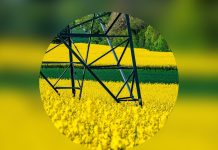
Aggregator Open Energi and sustainable development organisation Forum for the Future have launched The Living Grid, a platform to drive uptake of demand-side response and battery storage.
Open Energi clients Aggregate Industries, Sainsbury’s and United Utilities, are already onboard and the group wants other large companies to join what it is calling a “movement”, rather than a demand-response association or lobby group. Tarmac is also a supporter and collectively, the aggregator’s clients supporting The Living Grid represent 39MW.
The aim is to bring around 20 large corporates under the banner by 2020, and The Living Grid hopes to represents 200MW of flexible power at that point.
That deadline coincides with National Grid’s goal of achieving 30-50% of balancing services from demand-side response rather than through power stations by 2020.
While Open Energi is the founder technology partner and its clients the founder members, Giles Bristow, Forum for the Future’s director of programmes, hopes other aggregators will join the Living Grid and further its aims. So far, it has had discussions with Tempus Energy and a UK battery storage start-up about joining the group. Distribution Network Operators (DNOs) are also welcome to participate, says Bristow.
“Having one technology partner is a risk, but we genuinely want to bring in more technology providers – they might be on the generation side, might be in storage, might be other demand-side technologies too. The more the merrier – this is about critical mass and creating as much positive movement as possible.”
Pushing for change
It is “definitely not” a lobby group, says Bristow, “but [a forum for] telling positive stories that the proof of this type of technology is now low risk. I think that has been a barrier to people in the past. People worry about their kit and processes. But the internet of things has shown these are pretty low risk. So it is being part of a movement that is greater than the sum of its parts.”
“It’s a movement of forward-thinking organisations who want to bring a new approach to the energy system. The future needs to be quite radically different and we want to help prepare the ground for it.”
Fees and funding
While Forum for the Future is a charity, The Living Grid will be funded by a cut of the revenues that National Grid pays aggregators and participants for balancing services.
“At the moment there is no membership fee, [the funding] comes through our contract with Open Energi – and other technology providers in the future – so Open Energi is meeting our management costs,” says Bristow. Some of that money is put into an innovation fund to “further The Living Grid’s aims and to showcase other technologies,” he adds.
“We really hope Open Energi is the first of many technology providers, and that [its clients] are the first of many large corporates to join,” says Bristow.
Post COP21, he says, it an opportunity for the latter to demonstrate their commitment with “actions, rather than hollow words”.
Traction
The move comes as the development of the demand-side response market begins to accelerate.
National Grid has launched several new schemes, some of which have been over-subscribed. Meanwhile, aggregators are trying to scale their businesses to meet Grid’s ambitious targets, and energy suppliers are launching demand-side products to help them balance renewable portfolios, which have recently become more expensive to manage due to changes in market balancing and settlement rules.
At the same time, the government is planning reforms to the capacity market’s transitional arrangements which could mandate a minimum amount of demand-side response rather than generation being allocated contracts. It is also proposing to lower the threshold for market entry to 500kW, which would mean more entrants in the aggregator market.
The changes come as more and more businesses are moved to half hourly metering and settlement. This will expose them more fully to time of use tariffs for electricity, with potentially significant cost implications.
Those changes clear the path for increased take-up of demand-side response and storage, which the recent National Infrastructure Commission report said should be prioritised by government.
Find out more about The Living Grid here.
Related articles:
Free download: Demand side response report
New aggregator targets small firms with UPS for demand-response push
Government backs Adonis’ smartgrid plan, pledges £50m+ for storage and demand response
UK must prioritise smartgrid, says National Infrastructure Commission
National Grid says impact of solar requires greater system flexibility
Decc commits to annual plan and to consult on energy storage
National Grid to tender for 200MW of superfast demand response next month
Major changes to capacity market proposed
Hot technology: energy storage via heat battery
Utilitywise and Dell sign IoT energy management deal
Western Power Distribution ramps up demand-response trials, calls for participants
Smart grids ‘require local control and businesses must play or pay’
National Grid must simplify demand response to scale UK market
40% of firms say they could shift energy use as National Grid asks them to turn up
Dong enters demand-side response market with wind power balancing service
National Grid buys 475MW of demand response to cover winter
2016: the year half hourly settlement will hit your power bill
Government to consult on demand response in spring
Energy Technologies Institute: Let private firms run smartgrid trials
Flexitricity blasts transitional capacity market as Npower plots supermarket sweep
Grid buys 3.6GW of back up power to prevent blackouts
Flexitricity warns demand response cannot be rushed as winter looms
National Infrastructure Commission to focus on energy storage and demand response
Tempus: A five year old can see capacity market is anticompetitive
National Grid plots superfast grid balancing service
Many major energy users can’t be flexible, says manufacturing chief
National Grid moots demand side response rule changes as winter power margins tighten
Keep calm and scale demand response, says Scots energy inquiry
National Grid flags demand response changes, urges suppliers and TPIs to deliver
National Grid must simplify demand response to bring in UK businesses
Ofgem boss flags rule changes to speed demand response
National Grid launches major demand side push
Demand response: Suppliers and aggregators ignoring 80% of UK firms
UK firms with CHP plant could be paid to stop exporting power
National Grid: No margin? No sweat
Demand response provider teams with Honeywell, touts for new business
Free report: Directors’ energy outlook report 2016
Free report: How to finance energy efficiency
Follow us at @EnergystMedia. For regular bulletins, sign up for the free newsletter.



